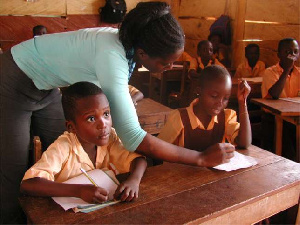
Despite earning a substantial monthly wage, young Opoku-Akyeampong remained resolute to fulfil his childhood dream of becoming a Lawyer. He therefore saved some money and travelled to the United Kingdom for further studies. He studied Law and qualified as a Barrister at Middle Temple in 1947. Barrister Opoku-Akyeampong returned to the Gold Coast in 1948. He did his pupilage at the chambers of Edward Akufo-Addo.
Barrister Opoku-Akyeampong established the Opoku-Akyeampong and Co. Chambers in the building next to the Adabraka Police Station. In Accra, he acquired a modern house at the newly built Ringway Estates and at Akropong his Residence was at what is now referred to as the Old Education Building.
By 1955, the idea of building a mixed-gender institution such as Achimota or on the model of English Private Schools struck Mr. Opoku-Akyeampong. From his balcony in Akropong, he had a picturesque view of the hills beyond the stream called ‘Nyaadabi’.
It was on this land that he decided to fulfil his vision. Barrister Kwaku Opoku-Akyeampong borrowed Eighty-One Thousand pounds sterling and bought all the stuff he needed for the establishment of Okuapemman School.
On Wednesday 8th February 1957 Okuapemman School opened its doors for academic work. Barrister Opoku-Akyeampong later invited some eminent people from all the divisional wings of the Akuapem State, that is, the Adonten, Gyase, Nifa, Benkum, Kronti and an expatriate, Miss I. M. Anderson then the Headmistress of Aburi Girls Secondary School to become members of the Board of Governors and attend the first board meeting. This, they did and twelve people in all including the founder who acted as chairman were present.
Okuapemman School started with 182 students; 159 boys and 23 girls in forms one to three. The pioneer teachers were only 6. The school started to run sixth form course in 1963. After the sudden demise of Barrister Opoku-Akyeampong, the government took over Okuapemman School.
For more than three decades now; The School has been running the inclusive education module, an educational system where visually impaired students and regular students are taught together and cohabitate, The School remains a model of inclusive education across Sub-Sahara Africa.
Visually impaired past students continue to exemplify The Schools motto of Semper Primus – Always First. Notable among such past students include Ebenezer Azameti (’12) President of Oxford University’s Africa Society; Lawyer Evelyn Appiah (the first visually impaired state attorney); Lawyer Isaac Topra Abradu (’04); Lawyer Carruthers Tetteh (’11) Seth Ativor (’04) who presently teaches in Okuapemman School
The entrance of Okuapemman School is a magnificent structure whose construction was financed largely by the 1982 year group. The entrance was designed by the highly regarded architect Prof. Edward Botchway. The topography of The School is characterized by a mountainous terrain with a significant green environment. Colonial era styled buildings, as well as modern architectural designs, can be found in The School.
Landmarks include ‘Sweet Mother’ (a concrete cast statue of a mother breastfeeding an infant); a bust of Barrister Opoku-Akyeampong, an arboretum which covers several acres and a modern 12-unit classroom block. Presently, Okuapemman School is a Category “A” coeducational institution with a Science Resource Centre, which has the physical infrastructure, the human resources, and a unique mandate to train students, who have normal vision and the visually impaired. The unique mandate of the school makes it the ultimate choice and destination for many families that are seeking an all-inclusive quality education for their children and wards.
Okuapemman School has a total road network of 3.4 kilometers, out of this, not even 10 meters of the entire road network is tarred. The dust from the untarred road poses a constant health hazard to students, staff and other stakeholders.
As they risk getting respiratory illness. The visually impaired who form a sizeable number of the school’s population, constantly struggle to find their way as it’s virtually impossible to differentiate between walking on the main road and walking on a footpath. In recent times, a visually impaired student broke his leg after he fell into the stream Nyaadabi, which runs through the school. Such accidents are easily preventable and having a tarred road network would go a long way in enhancing studies in The School.

As a concerned old student who is super proud of Okuapemman School, I respectfully call upon the Municipal government led by Hon. Asiedu-Larbi to immediately take steps to provide The School with a well tarred road network. It is worthy to note that, prior to being appointed as Municipal Chief Executive of Akuapem North; Hon. Asiedu-Larbi was the headmaster of the Basic School department of Okuapemman School.
It is also worthy noting that, the immediate past Municipal Chief Executive Hon. Dennis Miracles Aboagye is also a proud old student of Okuapemman School. In November 2918, the Minister of Roads and Highways toured The School roads and promised that work would commence immediately. Sadly, after half a decade, very little has been done with regard to tarring the road network in The School.
Under the fourth republic, we have experienced democrats, patriots, great alliances etc., but the roads that run through The School continue to deteriorate. We have witnessed ‘zero tolerance for corruption’; the ‘golden age of business’; we have had an ‘infrastructure king’ and the road continues to worsen by the day!! During the ‘year of roads’, we had hope that the roads would be constructed.
Sadly this never saw the light of day! In December 2023, Hon Kwasi Amoako-Atta Minister of Roads and Highways declared 2024 as ‘Year of Completion’ to complete all commissioned and stalled road projects in the country. It is therefore our utmost prayer that, the contractor assigned the project would immediately return to site and complete the road project within the shortest possible time.
Columnist: Odehye Labi Ansah-Koi





